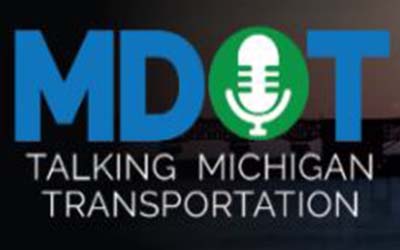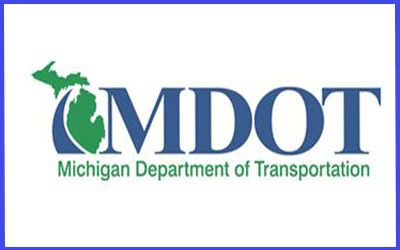
MDOT wins federal grants to enhance rural transit
|
|
|

|
|
|

Westbound Blue Water Bridge improvements will divert both bounds of traffic to eastbound bridge starting July 5
– The Federal Bridge Corporation Limited (FBCL) will complete maintenance on the westbound span of the Blue Water Bridge (BWB) from July 5 to Oct. 23. PORT HURON, Mich. – Beginning July 5 the Federal Bridge Corporation Limited (FBCL) will close the westbound span of the Blue Water Bridge (BWB) to complete maintenance. This project will be managed by the FBCL, and address required maintenance on the westbound BWB span connecting Point Edward, Ontario and Port Huron, MI. To reduce impacts to traffic, both bounds of the BWB will be carried on the eastbound BWB span. One lane will be reserved for westbound traffic entering the U.S. and two lanes will be available for eastbound traffic heading into Canada. While the eastbound BWB span carries bi-directional traffic, the following impacts to traffic will be in place:
The Blue Water Bridge is an essential economic link between Canada and the United States. This important project continues the commitment between the Federal Bridge Corporation Limited (FBCL) and the Michigan Department of Transportation (MDOT) to maintain and preserve the safety and reliability of the Blue Water Bridge.
For more information: |

MDOT awarded federal SMART grants for LANSING, Mich. – Two Michigan Department of Transportation (MDOT) projects, including the Blue Water Bridge International Smart Freight Corridor and Advancing Rural Mobility: Michigan Public Transit Open Data Standards Program, have been selected for funding through the U.S. Department of Transportation’s (USDOT) Strengthening Mobility and Revolutionizing Transportation (SMART) Grants Program. Aimed at providing predictable arrival and processing times for truck-borne goods movement across the Blue Water Bridge to the Port Huron Port of Entry, the smart corridor project will improve the flow of data between shipping companies, vehicles, border agencies, and infrastructure operators along this key international freight corridor. The $1.8 million SMART grant will support a pilot project to improve the movement of westbound goods across the bridge and minimize border waiting times and congestion when fully implemented. “Currently, trucks carrying freight across the border can experience lengthy delays at peak times. This project will decrease pollution from idling vehicles and decrease supply chain costs,” said Michele Mueller, MDOT’s senior project manager for connected and automated vehicles. “In 2020, $71.5 billion in goods passed over the Blue Water Bridge, so the potential benefits to the environment, along with a reduction of transportation costs, are tremendous.” When the project is complete, the system will be able to support pre-clearance of freight shipments and minimize queuing and backups, while maintaining data and information security. Longer distances between jobs, education opportunities, essential services, and recreation in rural communities can be a barrier to people with low incomes, people with disabilities, older adults, children, and teenagers who may not have access to a personal vehicle or be able to drive. Public transit is available in most communities, but finding out what services are available can remain a challenge. “The Advancing Rural Mobility Program (ARMP) seeks to provide access to real-time public transit information and improve people’s ability to plan and book transit trips in rural communities,” said Janet Geissler, mobility innovations specialist with MDOT’s Office of Passenger Transportation. “This project will help rural transit agencies create data feeds using open standards that allow the data to be shared easily and consistently. That data can be used to power such things as trip-planning apps, on-demand ride-hailing services, and MDOT’s planned statewide Mobility as a Service platform, which will help people in all areas of the state identify and access transportation options.” ARMP was selected to receive $1.3 million from the SMART grant program. MDOT has partnered with HNTB, an infrastructure design firm, and four rural public transit agencies to pilot the program: Benzie Transportation Authority, Charlevoix County Transit, Cadillac/Wexford Transit Authority, and Roscommon County Transportation Authority. The two MDOT SMART grants are among 59 projects across 33 states, totaling $94 million in funding for the first round of the program. The program provides funding to public sector agencies to conduct demonstration projects that use technologies and systems to improve transportation efficiency and safety. The City of Detroit and the Road Commission for Oakland County also were selected to receive SMART grant funding. |

FOR IMMEDIATE RELEASE March 21, 2023 248-361-6288 MorosiR@Michigan.gov MDOT public open house April 11 to discuss draft I-75 noise study in Oakland County
Troy, Mich. – The Michigan Department of Transportation (MDOT) is hosting a public open house to discuss the draft I-75 noise study in Oakland County. Presentations and experts to answer questions will be available. If unable to attend, a pre-recorded presentation will be available after April 11 on the City of Troy website.
Who: Interested residents Community leaders MDOT staff and consultants
When: Tuesday, April 11, 2023 5:30 – 7:30 p.m. Presentations are scheduled at 5:45 p.m. and 6:30 p.m.
Where: Troy Community Center Rooms 302 and 303 500 W. Big Beaver Rd. Troy, MI 48084
Accessibility: Accommodations can be made for persons who require mobility, visual, hearing, written, or other assistance for participation. Large print materials, auxiliary aids or the services of interpreters, signers, or readers are available upon request. Please contact Orlando Curry at 517-335-4381 or complete Form 2658 for American Sign Language (ASL) located on the Title VI webpage: https://www.Michigan.gov/MDOT/
Study background: This study is a result of a $300,000 grant awarded to MDOT from the Michigan Economic Development Corporation (MEDC) to conduct a traffic noise study on I-75 between 13 Mile Road and Adams Road in Oakland County. Information on the noise abatement program is available on MDOT’s website.
Public comment: MDOT is currently seeking public input on the draft noise report. Comments can be submitted via an online comment form, e-mail, phone, and in person at the public meeting. Provide your comments by April 25, 2023.
Monica Monsma MDOT Environmental Services Section 425 West Ottawa St. P.O. Box 30050 Lansing, MI 48909 517-335-4381 |

|
|
|

FOR IMMEDIATE RELEASE March 6, 2023 Lane closures on I-94 from M-19 to County Line Road through mid-May for bridge work in Macomb County LENOX TOWNSHIP, Mich. – Beginning 5 a.m. Wednesday, March 8, through mid-May, I-94 will have one lane open in each direction from M-19 to County Line Road for bridge work at M-19 (New Haven Road), 26 Mile Road, and County Line Road. Previously there were multiple locations with one lane open, this will now extend the boundaries from M-19 (New Haven Road) to County Line Road. A reminder: bridge rehabilitation work has closed County Line Road over I-94 in Macomb County for approximately two months. Only local traffic will be permitted on County Line Road between 26 Mile Road and 31 Mile Road. Traffic will be detoured: – Northbound County Line Road to westbound 26 Mile Road to northbound M-19 (Main Street/New Haven Road) to northbound M-19 (Gratiot Avenue) then to eastbound 31 Mile Road. – Southbound County Line Road to westbound 31 Mile Road to southbound M-19 (Gratiot Avenue) to southbound M-19 (Main Street/New Haven Road) then to eastbound 26 Mile Road. This work is part of a $32.5 million dollar project on I-94 from M-29 (23 Mile Road) to County Line Road which includes bridge work at six locations, traffic signal upgrades and partial ramp reconstruction at the I-94/M-19 and I-94/M-29 interchanges. Work will be completed by late fall. |